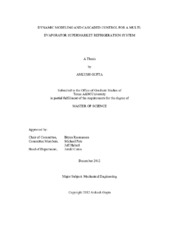| dc.description.abstract | The survey from US Department of Energy showed that about one-third of energy consumption in US is due to air conditioning and refrigeration systems. This significant usage of electricity in the HVAC industry has prompted researchers to develop dynamic models for the HVAC components, which leads to implementation of better control and optimization techniques. In this research, efforts are made to model a multi-evaporator system. A novel dynamic modeling technique is proposed based on moving boundary method, which can be generalized for any number of evaporators in a vapor compression cycle. The models were validated experimentally on a commercial supermarket refrigeration unit. Simulation results showed that the models capture the major dynamics of the system in both the steady state and transient external disturbances. Furthermore the use of MEMS (microelectromechanical) based Silicon Expansion Valves (SEVs) have reportedly shown power savings as compared to the Thermal Expansion Valves (TEVs). Experimental tests were conducted on a supermarket refrigeration unit fitted with the MEMS valves to explain the cause of these potential energy savings. In this study an advanced cascaded control algorithm was also designed to control the MEMS valves. The performance of the cascaded control architecture was compared with the standard Thermal Expansion Valves (TEVs) and a commercially available Microstaq (MS) Superheat Controller (SHC). The results reveal that the significant efficiency gains derived on the SEVs are due to better superheat regulation, tighter superheat control and superior cooling effects in shorter time period which reduces the total run-time of the compressor. It was also observed that the duty cycle was least for the cascaded control algorithm. The reduction in duty cycle indicates early shut-off for the compressor resulting in maximum power savings for the cascaded control, followed by the Microstaq controller and then the Thermal Expansion Valves. | en |


